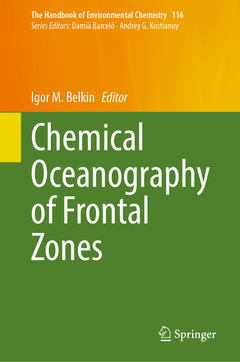Chemical Oceanography of Frontal Zones, 1st ed. 2022 The Handbook of Environmental Chemistry Series, Vol. 116
Coordonnateur : Belkin Igor M.

Igor Belkin holds a PhD in Oceanography from the Shirshov Institute of Oceanology, Moscow, Russia. Since 1973, he has been studying oceanic fronts, currents, and eddies in all five oceans from 72°N to 78°S, having spent five years at sea in 16 expeditions, including a six-month drift on the ice island “North Pole-22” in the Arctic Ocean. He also studied the Great Salinity Anomalies in the North Atlantic and climate change in the Large Marine Ecosystems around the world. Since 1997, he has been associated with the Graduate School of Oceanography, University of Rhode Island, Narragansett, RI, USA. Since 2019, he is Professor of Oceanography at the College of Marine Science and Technology, Zhejiang Ocean University, Zhoushan, Zhejiang, China, where he continues his global survey of oceanic fronts and eddies.
Outlines chemical and physical processes at oceanic fronts
Offers a global perspective on biogeochemical oceanography
Critiques marine pollution and ecology
Date de parution : 10-2022
Ouvrage de 443 p.
15.5x23.5 cm
Thèmes de Chemical Oceanography of Frontal Zones :
Mots-clés :
oceanic fronts; cross-frontal transport of nutrients; Persistent Organic Pollutants in frontal zones; Marine Litter Pathways; Aquatic Pollution; microplastics; mesoscale eddies; fish ecology; biogeochemistry; sedimentology; oceanography; Biooceanography; chemical oceanography; Marine Chemistry



